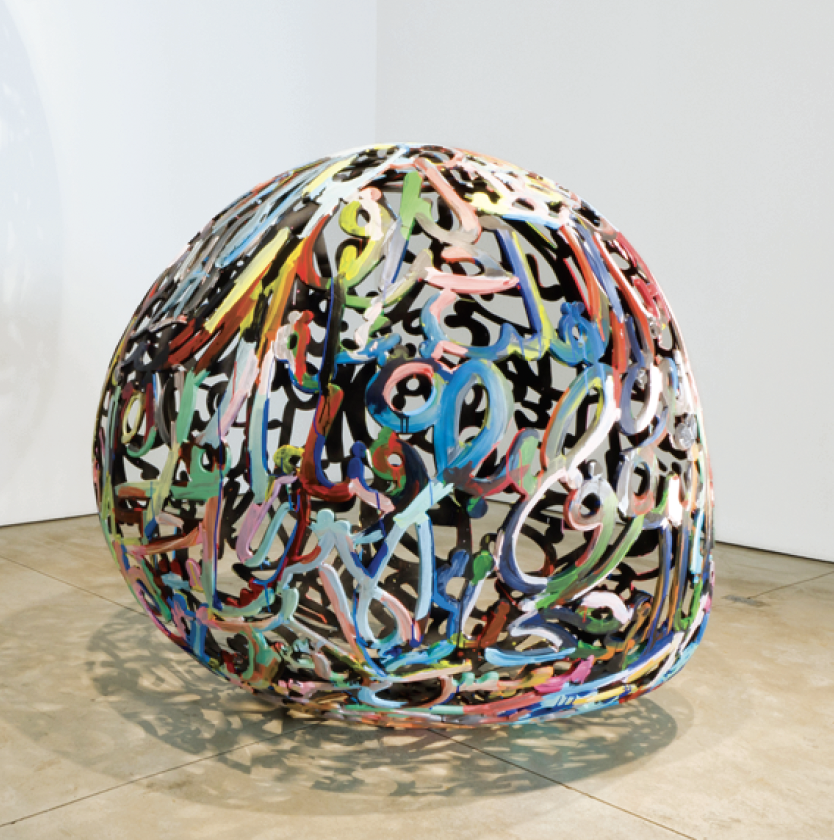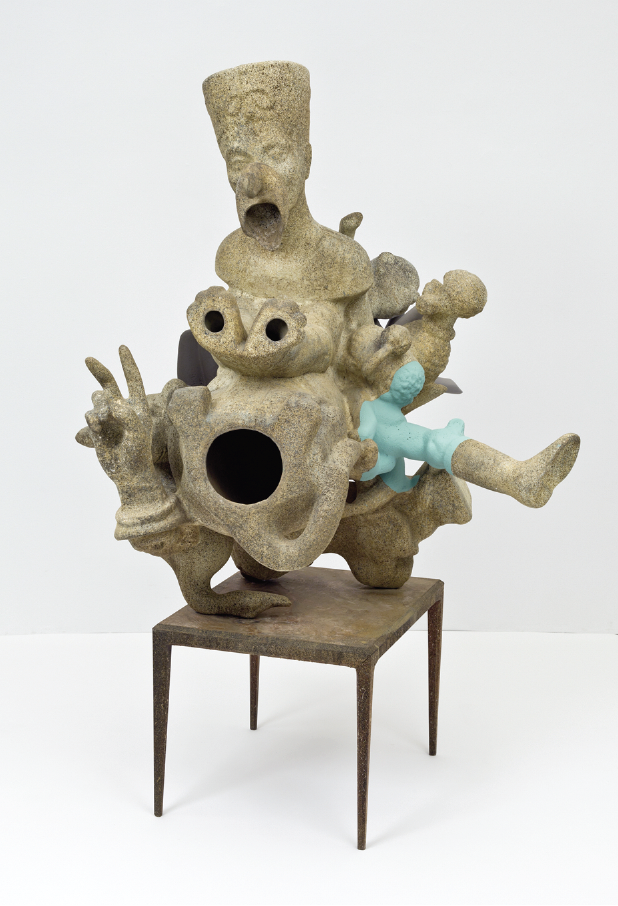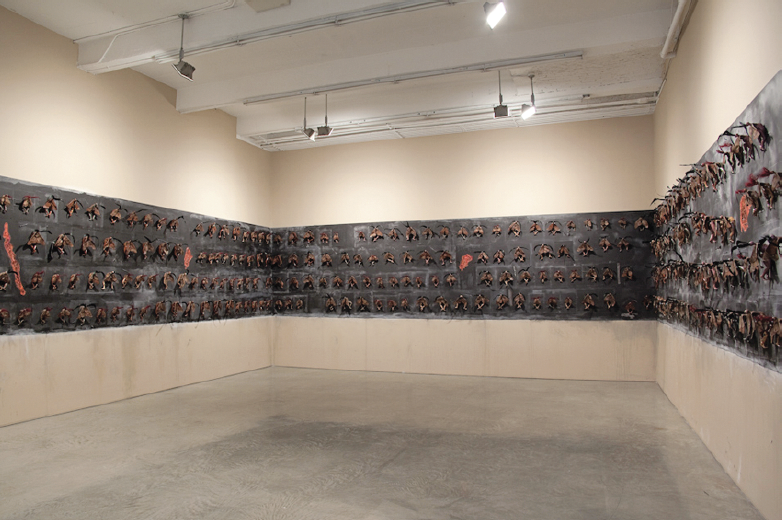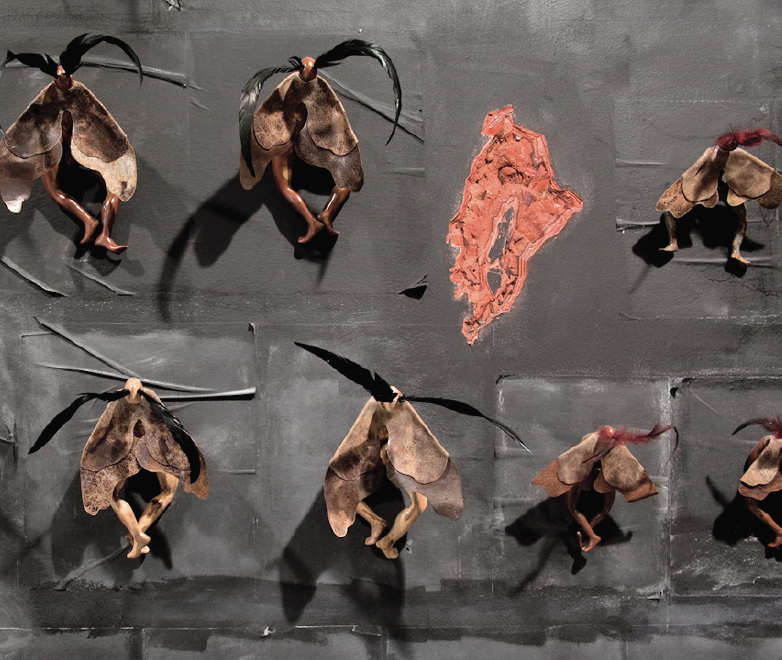Valérie Blass, Wangechi Mutu, Ghada Amer
A trio of exhibitions by women artists at the Musée d’art contemporain de Montréal this spring offered a prime opportunity to revisit the question of gender in art. Here, the Montreal artist Valérie Blass took up residence, for a spell, with Americans Wangechi Mutu (who is originally from Kenya) and Egyptian-born Ghada Amer. But the arrangement gave pause. On the one hand, such a roundup of feminist vigour might be seen as redressing an imbalance of long-standing. (When we see a trio of exhibitions by male artists we don’t think of it as a meditation on masculinity, just business as usual.) But this curatorial strategy can also be seen to perpetuate the ghettoization of female artists into a kind of curatorial menstrual hut, critically speaking, inducing us to read the work only in terms of how it reflects on issues of gender. It’s a severely restricted view.
The perils of this ghettoization become most obvious, of course, when the artists in question make work of widely divergent quality, as was the case here. The staging at the MAC implied an equivalence where, in fact, there was none. While Blass’s sculptures bristled with innovation and creativity, Amer’s works felt like a tired art world gambit—she was showing embroidered images of women from pornography and Disney cartoons transposed onto monochrome canvas backdrops—and Wangechi Mutu’s photocollages of semi-naked women, fluorescing with animal, vegetable and mineral embellishments, were only occasionally successful in conveying the transgressive, super-sexualized charge they aim at. A few moments with Mutu’s works and the intensity dissipates, and a sense of decoration sets in, leaving one feeling entertained rather than engaged. In short, Blass blew them both away.

Ghada Amer, 100 Words of Love, 2010, epoxy resin and acrylic, 170.5 x 182.9 x 172.1 cm. © the artist. Courtesy Cheim & Read, New York, and Musée d’art contemporain de Montréal.
This was the first survey museum show for the 44-year-old Montrealer, though she has been a standout in many group shows for years now. Curator Lesley Johnstone provided a thorough grounding in Blass’s distinctive way of working, clarifying the key ingredients in the artist’s sculptural DNA.
First is her neo-surrealist predilection for coupling forms in surprising ways, often conflating objects drawn from different realms of high and low culture. A prime example was the exhibition’s centrepiece: Déjà donné, 2011, a large work that cobbles together a motley collection of found objects—a bust of Nefertiti, a swan (which doubles as a kind of gaping mouth), a statuary hand, a cow-shaped creamer, a boot, a series of tumour-like growths, a number of ambiguous orifices. The resulting sculpture is a queasy hybrid, grotesque and uncategorizable, and hyper-fecund in a way that calls to mind Giuseppe Arcimboldo run amok, or first-generation surrealists like Hans Bellmer, or Louise Bourgeois, who emerged later. All, like Blass, have explored the boundary between form and chaos, with yearnings toward the inchoate.

Valérie Blass, Déjà donné, 2011, Styrofoam, epoxy finish, fibreglass, HYDROCAL FGR gypsum cement, pigments, 153 x 140 x 140 cm. Collection of the artist. Photograph: Guy L’Heureux. Courtesy the Musée d’art contemporain de Montréal and Parisian Laundry, Montreal.
Second is Blass’s address of time-honoured sculptural tradition. Her white plaster study in drapery, Ne faire qu’un ni même deux, 2011, reads as a kind of Baroque sculptural implosion, with the human figure having been subsumed into the rendering of texture for its own sake. (Think of a collapsed Pieta in which Jesus and Mary have gone missing.) In L’homme paille, 2008, Blass’s wooly protagonist appears slumped forward in thought, his foot resting on the replica head of King Tut. It’s an anti-monument in which the ennobling tradition of antique statuary is made a literal footnote. In Ce nonobstant, 2011, an icy blue female arm, wielding a pick with menace, emerges from within a standing monolith, a 21st century send-up of Michelangelo’s famous dictum that the sculptor’s task is to release the figure imprisoned within the stone. Blass seems to poke such pieties in the eye.
Third, Blass is funny. The essence of humour is surprise, and Blass jumps you from behind. Take her Touche du bois, 2009, an inverted tuning fork of wooden timbers clad in skin-tight blue jeans—Mick Jagger comes to mind—or Pont à poutre en porte-à-faux (from the same year), a concoction of wooden stakes and black fishnet stockings that suggests a collapsed goalie net or a woman’s legs akimbo. Your mind is formulating one interpretation even as the next intervenes, overturning it. The result is a cognitive release, a little chiropractic adjustment to the brain that yields pleasure, relief and the fresh flow of thought.

Wangechi Mutu, exhibition view and detail of Moth Girls, 2010, ceramic, leather, feathers, paper and wash, variable dimensions. © the artist. Photographs: David Regen. Collection Musée d’art contemporain de Montréal. Courtesy Gladstone Gallery, New York.
Finally, it seems that Blass can master any medium her ideas demand, whether she is working with coiled hair extensions, or a block of styrofoam painted to look like stone, or carved wood, or faux bronze, or the highly polished veneer of cheap ceramic gift shop souvenirs. With virtuosity, each idea is brought to life in the material best suited to it. There is no signature Blass look, only a signature Blass sensation.
The opposite is true of Ghada Amer, who here presented screen after screen of embroideries with their trailing ends left straggling, the threads obscuring the erotic imagery beneath. Amer makes us pause to decipher the imagery through the tangle, taking note of our own voyeuristic frustration in so doing, and briefly beguiling us by this usurpation of the traditional female craft of stitchery. But curiosity soon cools. I could recognize a work by Amer a mile away, but where would more thinking about it get me?

Wangechi Mutu, exhibition view and detail of Moth Girls, 2010, ceramic, leather, feathers, paper and wash, variable dimensions. © the artist. Photographs: David Regen. Collection Musée d’art contemporain de Montréal. Courtesy Gladstone Gallery, New York.
Likewise Mutu, who—for all her pictorial inventiveness—has always seemed to me to have a schtick. Her big-lipped and wide-hipped African queens are all female effulgence, but the mood fails to vary. She seems to take up the trope of the bejewelled exotic Negress, that figure popularized in colonial-minded 19th-century French painting and sculpture, presumably attempting to revamp it through the lens of fashion photography and pornography. But where she aims at critique she winds up in collusion. We don’t seem to have come a very long way, baby.
Leap from this to Blass’s petite, spike-wielding Femme panier, 2010, a female whirling dervish composed of equal parts femininity (the prim floral blouse), practicality (the basketry shelves in lieu of a torso, a metaphor clearly decipherable to any multi-tasking female), sexuality (there are those fishnets again), and primordial, witchy menace (her left hand is blackened and inscribed with a skull and bones). We like her. We fear her. Mostly, we want to stay out of her way. Swift, sexy, agile, fearless, a figure of force and agency—Blass’s heroine throws down the gauntlet. Enter ye who dare. ❚
Valérie Blass, Wangechi Mutu and Ghada Amer exhibited at the Musée d’art contemporain de Montréal from February 2 to April 22, 2012.
Sarah Milroy is a Toronto-based writer.

